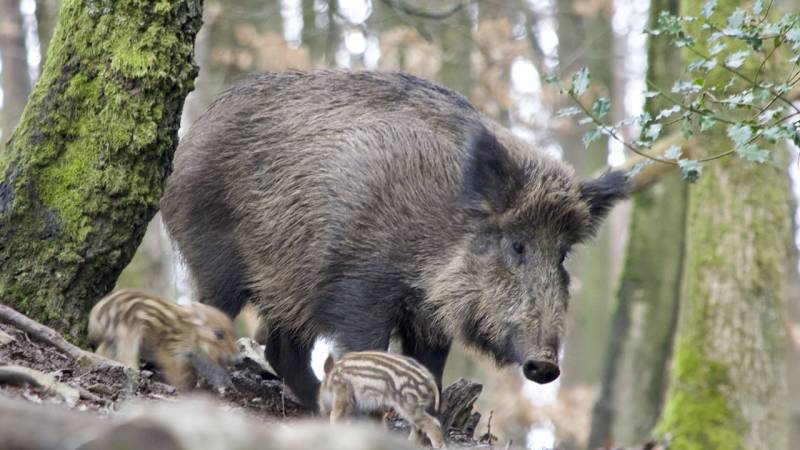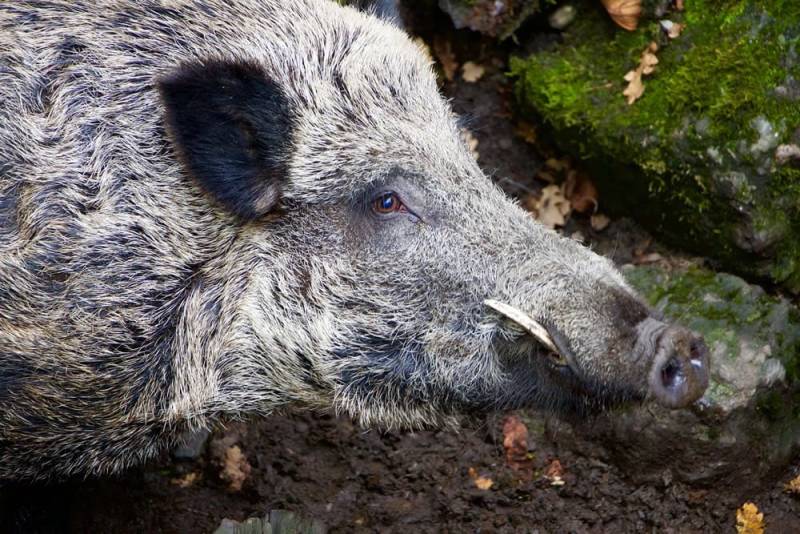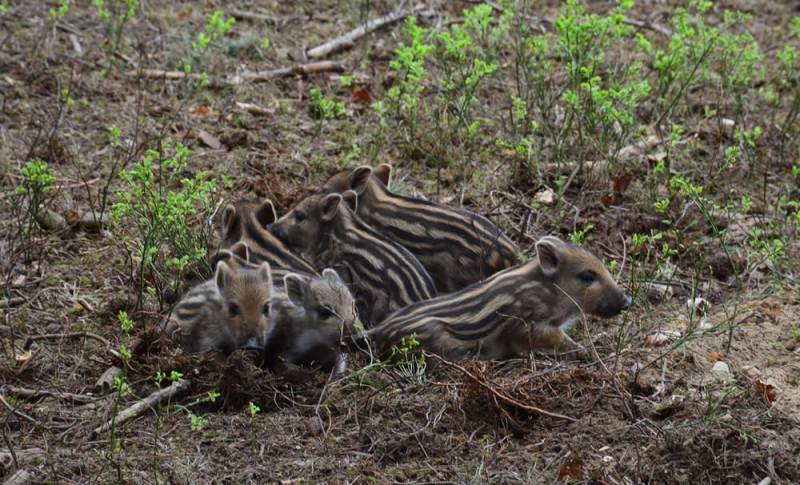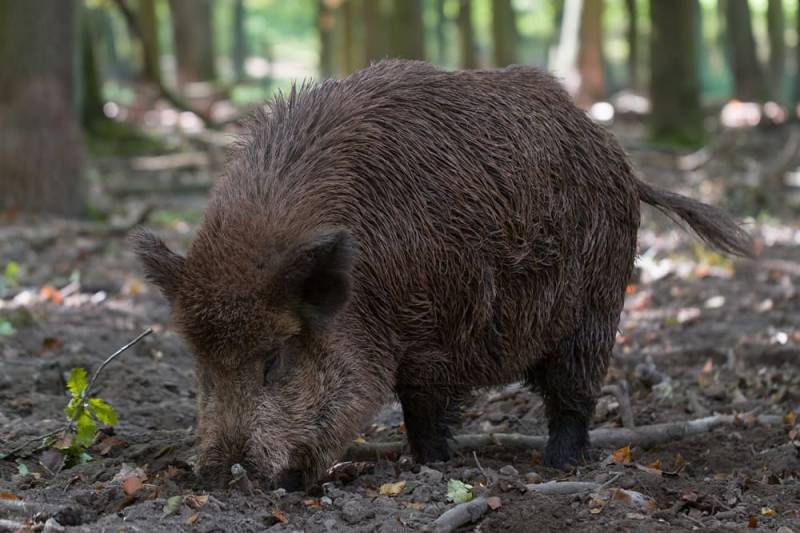
How do I behave correctly around wild boars?
👉 The key facts from this guide
- Wild boars can be found in almost all of Europe, North Africa, and parts of Asia. They prefer large forested areas with marshy ground and dense undergrowth.
- Wild boars are omnivores, with only about 10% of their diet consisting of animal matter. They have a well-developed sense of taste and smell and can even distinguish between different varieties of potatoes and apples.
- Wild boars are usually peaceful and harmless animals, and not aggressive. However, they feel threatened if you come between a sow and her piglets, if a dog barks or chases after them, or if they are injured.
- If you encounter a wild boar, remain calm, make no sudden or frantic movements, do not feed the animal or try to show dominance and superiority. Also, do not run away, as a wild boar can easily catch up with a human.
- It is particularly dangerous to be in the woods at dusk or at night, as wild boars do not expect to encounter humans at this time and can be surprised and overwhelmed by an encounter.
The forests in this country are not dangerous.
However, you will have great respect if you encounter a wild boar in the wild on a tour.
Due to their stocky physique and their particularly sharp tusks, the animals appear dangerous.
If you want to know how to behave appropriately when encountering a wild boar, then you're in the right place.
The Wild Boar
The animals seem mostly friendly, nevertheless caution is advised in such a confrontation.
You should first learn something general about the bristly animals. Only then will I tell you about the possible dangers and how to avoid them.
Physical Characteristics
A wild boar is a stately animal. Adult males, also known as boars, weigh up to 400 kilograms.
Meanwhile, females, known as sows, weigh around 100 kilograms. They can reach a body length of up to 180 centimeters and a shoulder height of about 110 centimeters.
The most distinctive feature of a wild boar are the long tusks growing outwards.
In females, these are called hooks. The tusks of males are referred to as ivory in the upper jaw and as weapons or rifles in the lower jaw.
They are razor sharp, and the animals even use them to dig up the ground.

Habitat and Distribution
The wild boar can be found almost throughout the European area, with the exception of the Scandinavian countries. There are also wild boars in North Africa and parts of Asia.
The animals prefer large forest areas with swampy soil and a lot of undergrowth. They spend their days in basins, simple ground hollows.
Social structure and offspring
In basins, the sows also give birth to their offspring. The young animals are called piglets.
These farrowing basins are constructed by the sows with great effort. They also have to keep the young animals warm in winter.
The main time for giving birth to young is between March and May. The sows live together with their young in sounders. These are familiar groups consisting of eight to about 30 animals. The boars are generally solitary.
The sows join together with their young and last year's piglets to form a sounder. Other sows with their offspring are usually also part of it. There is a lead sow who guards and protects the sounder.
A matriarchy prevails among wild boars. This means that the females have the say. The sows give birth to four to eight piglets once a year.
Wild boars are highly intelligent and cautious animals. If they are not shot or run over, the life expectancy of a wild boar can be up to 20 years.
Nutrition
The wild boar is an omnivore. The proportion of animal food is only about 10 percent. One of the few foods that wild boars do not like are chestnuts.
The animals have a strong sense of taste and smell. They can distinguish between different types of potatoes and apples.
It happens that animals visit potato, cereal, or beet fields and dig them up. In doing so, they destroy a large part of the field. The soil is broken up by their tusks in search of food.
In fall, the animals become more active again. They go on intensive food search to build up some winter fat.
The Dangers
Wild boars are peaceful and harmless animals. Usually, they are not aggressive either.
In an encounter, they are more scared of you than you are of them.
Humans are enemies of the bristly animals. Originally, they were active during the day, but since humans began to hunt them, they shifted their active time to twilight and night.
As long as you are on forest trails and stay there, the animals observe you. There, you are predictable to them and pose no threat.
You will only occasionally encounter a wild boar on a paved forest trail. They usually just quickly cross such a trail. A dog bite is even more likely than being attacked by a wild boar.
Nevertheless, there is still a chance of meeting them. However, it only gets really dangerous in four extreme situations, which I will now explain to you.
The Youngster
If you get between a sow and her piglets, she feels attacked and will defend herself and her offspring with her life. Even if you had no ill intent.
However, you will be warned if you approach a sounder. The sow will make herself noticeable by loud snorting.
For this reason, pay attention to your surroundings and listen carefully if you can detect any sounds.
If you notice the snorting of a wild boar, turn around and go back the same way you came.
Don't start running. If you leave the wild boar alone, it will also leave you alone.

The aggressive dog
When you are walking in the forest with your faithful companion, it can be dangerous.
A wild boar will never attack a dog or a human without reason.
However, if your dog tries to defend you and chases or barks at the wild boar, it is likely that the boar feels threatened. Out of fear, the wild boar may attack your dog - and in the worst case, also you.
Always keep your dog on a leash. In many areas, there is usually a leash law for dogs. Follow it.
The injured boar
An injured boar is very aggressive and prone to attack. This mainly happens through car accidents or when a hunter has made a non-lethal shot.
An injured boar is driven by blind rage and is extremely dangerous. If you come across one, move away from it slowly. Immediately inform the police when you have taken enough distance from the animal.

Unpredictable in the darkness
It is especially dangerous when you are in the forest at dusk or at night. During this time, the animals do not expect humans.
When they encounter you, they are primarily surprised and overwhelmed by the encounter. At this moment, the animals are unpredictable. You cannot assess them.
It is like in a dangerous situation with humans: either flight or fight. If the animal flees, it is good for you. However, if it attacks you, it does not end well for you.
Therefore, avoid hiking or mushroom picking late at night. The best time for the latter is in the early morning hours anyway.
The Encounter
You encounter a wild boar, but it is not acting aggressive or hostile towards you? For many, this idea is very creepy. But I'll tell you how to handle this encounter correctly.
The best thing to do is to ignore the animal.
Do not be tempted to pet the wild boar. It could interpret the approach as an attack and want to defend itself.
Instead, just keep walking and avoid sudden or hectic movements. Also, do not feed the animal.
Never try to show dominance and superiority. Do not attack the animal with a stick or anything similar.
A wild boar is aware of its strength and weight. One of these animals can easily take on a human. Do not provoke this, as adult boars weigh up to 400 kilograms.
Do not run away either. That will not help you, as a wild boar can easily catch up to you. Stay calm and enjoy this extraordinary encounter.
Do you really want to meet such a bristling creature or can you safely avoid this encounter? Have you ever encountered a wild boar? How was this experience for you? Were you afraid? How did the animal behave? How did you react?
Share your experiences in the comments!
Also, check out my article on other dangers in the forest.


Author of the guide
Martin Gebhardt
Hey, I'm Martin. On my blog, you will learn the basics and numerous details about living in the wild. I think survival, bushcraft and the good life in nature are the keys to happiness. Find me here on Instagram or on YouTube. You can find more about my mission on the About Me page.
Was this guide helpful?
61 people found this guide helpful.
4.87 out of 5 points (63 Ratings)
Comments (0)
This post may contain affiliate links. So if you click on the links and make a purchase, I will receive a small commission at no additional cost to you. Click here, to learn more about it.


